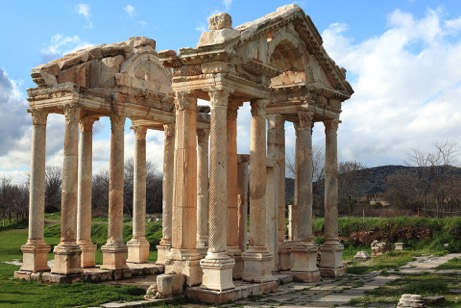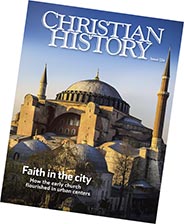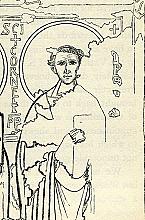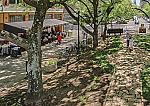Life in the earthly city

FROM THEIR FIRST HEADQUARTERS in the holy city of Jerusalem, to their future Western hub in the imperial city of Rome, the apostles’ mission was an urban one. As they set out to fulfill Jesus’ final commission, recorded in Matthew 28:19, their route from Jerusalem, to Judea, to Samaria, and to the ends of the earth (Acts 1:8) leapfrogged from one ancient Near Eastern city to the next.
The apostle Paul pursued this path with such zeal that he eventually thought he had saturated the area “from Jerusalem all the way around to Illyricum” (Rom. 15:19, 23) and so headed off toward Spain. By the late second century, the Way (one of the earliest names applied to Christianity) began to look like a truly global urban movement. The Epistle to Diognetus (second century) claims, “What the soul is in the body—that is what Christians are in the world. The soul is dispersed through all the members of the body, and Christians are scattered through all the cities of the world.”
Docking in every port
The apostles started by targeting the ports—bustling urban crossroads akin to modern airport hubs. There they found an environment conducive to their message. For one thing there were a lot of people: population density estimates for the time run as high as 200 per acre—about 15’ x 15’ of living space for each man, woman, and child. Even better, those people were educated, employed, and cosmopolitan—the sort of folk who welcomed the open exchange of ideas about everything, including religion. Where commerce and trade flourished, education thrived and ideas percolated.
Paul, the missionary to the Gentiles, was a city boy himself. He had grown up in Tarsus—“a city of great importance,” as he says in Acts. He was a tentmaker, not a farmer. His language is peppered with athletic imagery from the urban stadium games—running races and competing for the crown (Gal. 2:2; 5:7; 1 Cor. 9:24–25; 2 Tim. 4:7–8), or beating the air like a boxer (1 Cor. 9:26). He knew what was going on in the pagan temples, where the temple prostitutes plied their wares and the priests sold the meat left over from sacrifices. His letters and those of other New Testament writers confront life in the city: false gods, sexual immorality and prostitution, drunkenness and orgies, the temptations of wealth and ambition, flawed business ethics.
He had to remind his urban readers that their real citizenship was in heaven, even as he called on them to be good citizens and followers of the Way here on earth. But this was not always easy.
From gods to banquets
The cities fostered a culture of materialism and indulgence, in which the Greco-Roman aristocracy could wile away their time drinking and eating at lavish banquets, applauding at the often immoral theater entertainments, and paying homage to the gods and the divine emperor himself. The games, the theater, the baths, public events honoring the emperor—these were all part of the culture, and everyone was expected to participate. And everyone could because all educated citizens shared Greek or (later) Latin as the common language of school and marketplace.
Religion permeated these activities. The gods were given their due not only in the temples but also in the Colosseum, the theaters, and the camps of the military legions. If Jews or Christians wanted to be a part of all this, the price of admission was conformity. It was their civic duty to honor the Roman gods and adopt the Roman lifestyle.
To combat the tug and pull of Roman culture, the early church offered an alternative culture—a new habitus: a way of living in light of a higher culture and a higher purpose. These Christians talked about “living by the Spirit” and not giving in to sexual temptation; they championed almsgiving and caring for the poor and defenseless; and they singled out for special care widows and orphans as the weakest and most vulnerable in society (see “Healing the city,” pp. 17–20). To them all of life, no matter how small or insignificant, was valuable in God’s eyes and in the church’s.
Even in the face of widespread government discrimination and cyclical persecution, the early church taught obedience to the state’s authority and laws. In business one was to be honest; in public and private life, submissive and long-suffering. Children and slaves were not to be mistreated. Parents and masters were to be obeyed and honored. The countless immigrants who streamed into the Roman cities found little welcome there from the dominant culture. The Christians, however, embraced the alien and the stranger in their midst, opening their homes and hearts (see “Citizens of no mean cities,” pp. 36–40).
Based on the accounts of apostles like Peter and Paul preaching in the public square, sometimes performing signs and wonders, and occasionally reeling in a large catch of new believers, one might expect to find such public displays in church services. But the church’s target audience was already used to being welcomed at civic pagan rites and ceremonies. These showy public spectacles compelled little commitment, just as long as the gods were honored. Christian churches, by contrast, largely closed their services to outsiders, allowing only those instructed for baptism into the “mysteries of the faith” to participate. Their disciplina arcani (ancient disciplines) called not only for a life of renunciation, but also a promise to keep secret the mysteries (sacraments) of the church.
Ways of life and death
Would-be joiners must also have had a sponsor invite and vouch for them. No one just walked into church.
Nor was entry quick or automatic for the seeker. The program of instruction for new members was dauntingly thorough—sometimes lasting as long as three years. New believers were required to commit themselves not only to learn the doctrine of the early creeds, but also to practice a new “Way” of life contrasting with the city’s way of death. As the early Christian behavior manual, the Didache (first/second century), put it, “There are two ways, one of life and one of death; but a great difference between the two ways.”
Given these rigorous requirements, how did the church grow? As historian Alan Kreider put it, in the first centuries of the church, growth was more like a “patient ferment” than an explosion. Like yeast spreading through dough, missionaries worked along a web of connections made possible by life in the city. In each of these connections, a potential convert would come into contact with the countercultural Christian habitus. Even one convert could yield an abundant harvest as Christians rubbed shoulders with their neighbors and the yeast continued to spread.
Paul often had “chance” encounters with individuals as he was led by the Spirit. A single conversion often resulted in the rest of the household being baptized as well: Cornelius in Joppa (Acts 10), Lydia in Philippi as well as Paul’s jailer there (Acts 16), Crispus in Corinth at the house of Titius Justus (Acts 18)—all confessed their faith and were baptized, along with their entire households. Households in the cities at the time of the early church were extended affairs under one roof. They included the paterfamilias, or head of the household, his spouse, his children, his servants and slaves, former slaves who might now be clients, and often tenants or people with whom he did business.
Work was another avenue of connection. Paul may have worked his trade in the tentmakers’ section of each city. Just like New York’s garment and meat-packing districts, Ephesus might have had a leatherworkers’ district or a metalworkers’ district.
The tent workshop may have even been a base of operations for Paul’s preaching and teaching in Ephesus, Corinth, Thessalonica, and other places. In his first letter to the Thessalonians, Paul wrote, “Surely you remember, brothers and sisters, our toil and hardship; we worked night and day in order not to be a burden to anyone while we preached the gospel of God to you” (1 Thess. 2:9).
 Order Christian History #124: Faith in the City in print.
Order Christian History #124: Faith in the City in print.
Subscribe now to get future print issues in your mailbox (donation requested but not required).
Besides business connections, there were also voluntary associations—like today’s clubs. Tertullian speaks of these types of associations in his Apology. Clubs provided social interaction but also identity; they might include members of a particular trade or religion, or be organized around certain civic duties or associations. Many of these clubs would hold banquets or festivals in honor of patrons, living or dead. In fact belonging to such a society would ensure one a burial place, no small concern in antiquity when many of the poor were simply buried in mass graves with nothing to mark their existence.
To many outside observers, Christianity and its secret meetings seemed like a type of private club or society as well. But it was also different, as Tertullian (160–220) made clear. A great theologian and apologist, Tertullian lived in the prosperous city of Carthage (in modern Tunisia, North Africa). The Christian community to which he belonged provided a support network for the benefit of needy members and the larger community alike. Members voluntarily contributed to a “treasure-chest” once a month; Tertullian called these gifts “piety’s deposit fund.”
Social networks and distractions
The Christians around the empire were plugged into the social network of the cities, and to that network they modeled an alternative habitus, adaptable across classes and cultures, eras and economies. The habitus centered on the two poles of the Law Moses had taught and Jesus had reiterated: Love God and love your neighbor (Matt. 22:37–39). The love of God was cultivated in the liturgy and the gathering together; the love of neighbor was cultivated at home, at work, in the marketplaces, and in the streets.
But Greco-Roman cities were filled with distractions to stimulate the appetites. Gladiators and charioteers of the ancient world were like modern sports stars; beyond their public violence and thirst for blood, a lot of sex, drinking, and gambling went on as well. The graffiti in Pompeii is quite revealing—recording sexual slurs and conquests (heterosexual and homosexual) along with bar fights and thefts, among other things.
The theaters held classic comedic productions by artists such as Seneca and Terrence, but the subject matter often revolved around sex and infidelity with plots that today would be rated R if not NC-17. John Chrysostom (d. 407) excoriated his congregation at Antioch for coming to church—if they even could make it there—and then leaving Christ lying in the manger to rush off to the theater to see “naked women swimming.” Citizens were bombarded constantly with images: erotic art appeared everywhere, and the baths invited promiscuity and prostitution. The Romans had at least 50 different words to identify the various types of prostitutes one could find in the cities. Society and culture were structured to tempt; and if not to tempt, then to distract; and if not to distract, then to coarsen and desensitize.
In the city as a desert
Christians did not live indifferently in the face of such temptation and violence. Theophilus of Antioch (2nd c.) explained in a letter to Autolycus, a pagan friend, that Christians avoid sex outside of marriage and “are forbidden so much as to witness gladiator shows lest [they] become partakers and abettors of murders.” Clement of Alexandria noted in his Stromata (or Miscellanies, a book of miscellaneous comments on the Christian life) that a Christian, while “inhabiting the city, despises the things in the city which are admired by others. He lives in the city as in a desert, so that he may not be pressured into conforming to his environment, but instead chooses to exhibit a life lived justly.”
Ambrose praised the fourth-century bishop Eusebius of Vercelli, who was capable of “living in the city [while] observing the rules of the monks, and ruling the Church with fasting and temperance. For the grace of the priesthood is much increased if the bishop constrain young men to the practice of abstinence, and to the rule of purity; and forbid them though living in the city, the manners and mode of life of the city.” All of this attracted people who knew the culture of the Greco-Roman city was dragging them down but didn’t know what to do about it. Christianity offered another way—the Way.
One of the most promising escape routes from trouble, some city-dwellers thought, was wealth: enough money could take care of most, if not all, of life’s problems. Great wealth could be obtained in the cities. But the rich often got richer while the poor got poorer. The second-century churchman Clement of Alexandria (c. 150–c. 215) lived in probably one of the wealthiest cities of the empire. He preached a sermon on whether the rich could even be saved in the face of the distractions and distortions to the faith their wealth could produce. His conclusion was ambiguous: wealth definitely had its drawbacks, but where would the church get its funding for helping the poor and the destitute if not from the wealthy?
Ambrose (c. 340–397) served as a city magistrate and was well aware of the temptations, but also the advantages, that wealth and power could provide. In fact many of the leading bishops of the early church occupied sees that put them close to the seats of power. Rome, Milan, Antioch, Constantinople, Alexandria, and Carthage all offered considerable power, wealth, and prestige.
Some bishops, like Ambrose, were themselves former government officials. They knew how the system worked and were often tapped to provide governmental services. They resolved disputes and provided aid for the poor and indigent—often from their own funds. Many of the bishops originally came from wealthy families and used that wealth in service to the church and their communities.
A tale of two cities
Basil (330–379), bishop of Caesarea, built a city within a city—actually on the outskirts of the city—to provide for the sick and the sojourner. He also encouraged his wealthy parishioners to put their money where their faith was. Combining his own wealth and theirs, he built one of the first hospitals, the Basileiad (named after him). It was a place of refuge for the poor, sick, and destitute; not only a hospital but a soup kitchen, a homeless shelter, a place where people had their needs met during difficult times and where the aid they received was accompanied by compassion and respect—providing a “double relief.”
Basil’s friend Gregory of Nazianzus (329–390) called Basil’s project a “new city,” the “storehouse of piety and the treasury of the wealthy . . . where disease is regarded in a religious light, and disaster is thought a blessing, and sympathy is put to the test.”
Urban centers presented the early church with challenges and opportunities. The extent to which Christians dealt with these depended on how they viewed their ultimate citizenship: they were to be in the city but not of the city. No one knew this better than Augustine (354–430). Augustine’s City of God is the original tale of two cities. There is “a City of God whose Founder has inspired us with a love and longing to become its citizens.” There is also an earthly city whose inhabitants “prefer their own gods to the Founder of the holy City, not realizing that He is the God of gods.” These two cities compete for our attention.
Christians are called to dual citizenship, however, until Christ returns. At that time he will bring with him a new city, “the new Jerusalem, coming down out of heaven from God” (Rev. 21:2–4). God’s plan of salvation began in a garden, but it ends in a city—a new city, a holy city, a city where there will be no more sin, death, mourning, crying or pain, for the old order of things has passed away because God himself will live with his people in his city. CH
This article is from Christian History magazine #124 Faith in the City. Read it in context here!
By Joel C. Elowsky
[Christian History originally published this article in Christian History Issue #124 in 2017]
Joel C. Elowsky is professor of historical theology at Concordia Seminary, St. Louis, a Lutheran pastor, and editor of the Encyclopedia of Ancient Christianity and of volumes in the Ancient Christian Commentary on Scripture, the Ancient Christian Texts series, and theAncient Christian Doctrine series.Next articles
A bishop’s work is never done
During and after persecution, new complexities challenged church leaders
Helen Rhee“An expanding circle of love and justice”
We spoke to Katelyn Beaty, editor at large for Christianity Today, on how Christians today interact with their non-Christian neighbors.
Katelyn Beaty and the editorsHealing the city
How Christians helped the sick and poor in the Roman Empire’s cities
Gary B. Ferngren“The only stumbling block is the cross”
We spoke to Doug Banister, the pastor of All Souls Church in Knoxville, Tennessee, about how his church does urban ministry.
Doug Banister and the editorsSupport us
Christian History Institute (CHI) is a non-profit Pennsylvania corporation founded in 1982. Your donations support the continuation of this ministry
Donate





